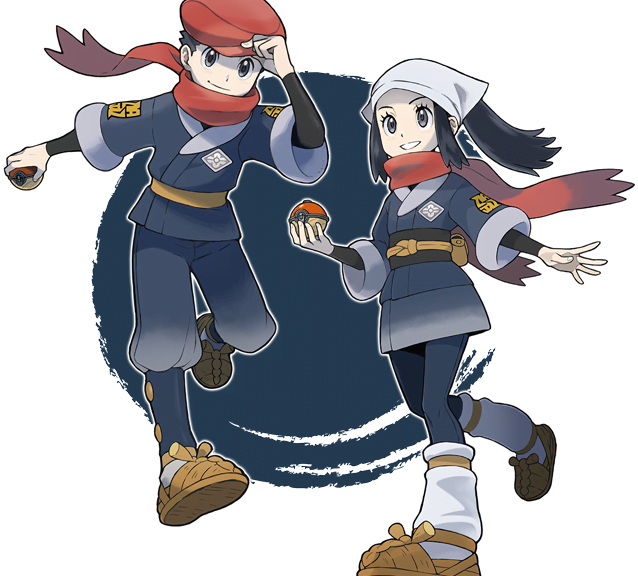Pokémon Legends: Arceus – a Team Galactic link and Starters explained
Suspicious logos on the protagonist’s clothing suggests a reference to Galactic. We also explore why these specific Starters from different regions may feature in this game.
Pokémon Legends: Arceus was announced today, and with it came the official website, supplying images and information. It was noticed by TKHdeR on Twitter that the clothes on the protagonists – looking a lot like Lucas and Dawn – contain an interesting emblem.
Hello world. New logo can be read “銀”(gin). This Kanji also used in “銀河”(ginga). “Ginga” means “Galactic”. As you can see, it’s resembles Team Galactic’s logo very much. I’m sure it’s NOT a coincidence. pic.twitter.com/xP7osCgaKo
— タカハ / Takaha 🇬🇧 (@TKHdeR) February 26, 2021
We can confirm – thanks to our resident translator Cherrim – that this translation is accurate. That begs the question, then, why are they wearing clothes with such a clear relation to Team Galactic?
Perhaps it is a case of Pokémon Legends: Arceus being the first game chronologically – after all, the game is set in a “long-gone era, before ideas such as being a Pokémon Trainer or having a Pokémon League even existed”. As such, Team Galactic came afterwards, and simply modelled their logo on this one. That would be a nice bit of continuity between the Sinnoh games. However, it doesn’t explain why the word Gin or Ginga (Galactic) is etched on the clothing here, either.
A more outlandish direction of speculation is that they are more directly linked, and Team Galactic are at play with the power of time travel. Crazy? Perhaps, but recall that Cyrus, leader of Team Galactic, was after the Legendary Pokémon of Space and Time, Dialga and Palkia. We also know that a multiverse, or parallel worlds exists, thanks to Pokémon Omega Ruby and Alpha Sapphire. And as mentioned, the protagonists here look a lot like the original Sinnoh ones.
I don’t think hence it’s too unreasonable to speculate that in another version of Sinnoh, Team Galactic had some sort of success, and affected an older version of Sinnoh. Or perhaps Cyrus went back in time to try to find a new world he would prefer, lacking in emotions? It’s unclear, but given the focus of the game on Arceus as well, there’s room for this theory to thrive. One big hurdle with this idea, however, is why you, as the player character, wear clothes bearing a logo with links to Team Galactic.
Of course, a far more boring reasoning is that it is little more than a reference. After all, Team Galactic in itself is merely a reference to another group made by Game Freak – the Galaxy Gang (or in Japanese ギンガ団 – “Ginga-dan”), the villainous group in the action platformer Pulseman. Bonus – the character Pulseman is also referenced by the Pokémon Rotom!
Another curious aspect of Pokémon Legends: Arceus is the selection of Starter (or Partner) Pokémon. Not a single one is from Sinnoh – instead, we have Rowlet, Cyndaquil, and Oshawott. Why these three?

Firstly, it could be a case of theme. Rowlet evolves into Decidueye, an assassin wielding a bow, while Oshawott evolves into Samurott, who carries with it a hidden sword. These seem like they would fit in an older time period of a region based in Japan. Admittedly, Cyndaquil is harder to fit, although it does learn Smokescreen early on – a ninja-themed attack might be the relation here. However, it could be due to a basis on the Japanese badger, depicted in folklore as yokai that can transform and deceive. Furthermore, the Japanese name for Typlosion is ‘Bakufun’ – the word ‘bakufu’ translate as shogunate, the office or government of the shogun (leader).
Speaking of, perhaps we should also focus on the animals the Pokémon are based on. Owls certainly occupy the snowy Hokkaido region, which Sinnoh is based upon – an easy relation there, and we know owls also live in other parts of Japan. While honey badgers, another clear basis for Typhlosion, do not live in Hokkaido but are otherwise endemic to other parts of Japan, this may make sense – after all, as the official website states:
These three Pokémon arrived with a Pokémon Professor, who encountered them on research excursions to various regions.
But if one insists, then the Cyndaquil and Quilava species can also be said to draw inspiration upon shrews and weasels, which do live in Hokkaido. This well-researched article also points out that Cyndaquil may be based upon the Fire Rate myth or youkai, which supposedly was never claimed to be native to Japan – rather, it fitted in China.
Oshawott is, well, based on an otter. There existed a Japanese river otter – existed, we say, because it is an extinct variety of otter, which died out in the mid to late 1990s. While a few sightings of otters in Hokkaido have been made in the last five years, it has not been confirmed to be this species of otter. But there you have it – in previous centuries of Japan, it makes sense that Oshawott would have been seen by a travelling Professor, when it in current times hails in Unova, a region based on New York rather than part of Japan.
What are your thoughts and theories on Pokémon Legends: Arceus?
Edited by Sheep and Zach.
